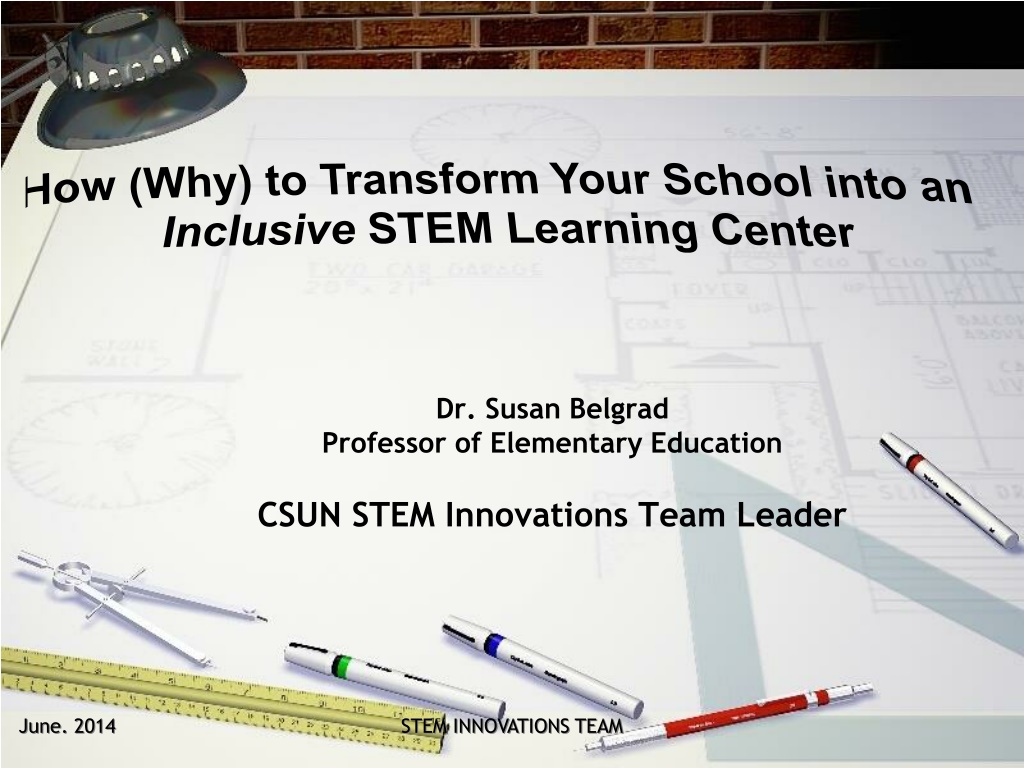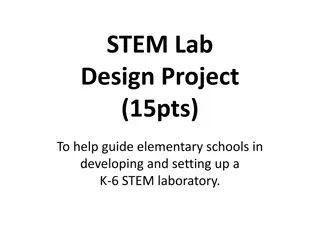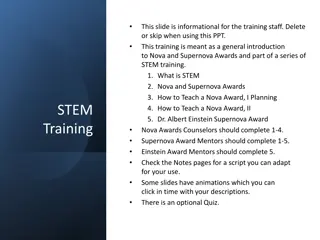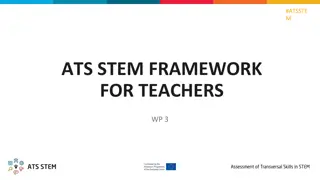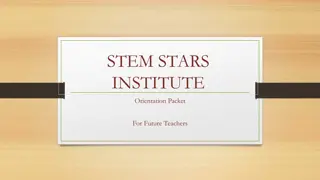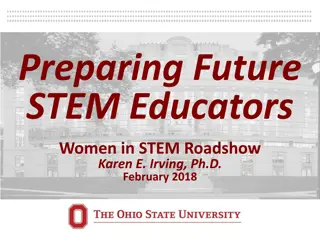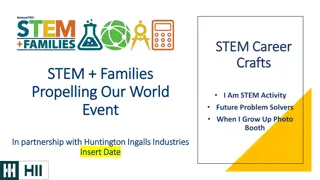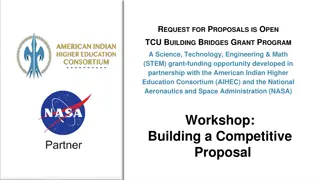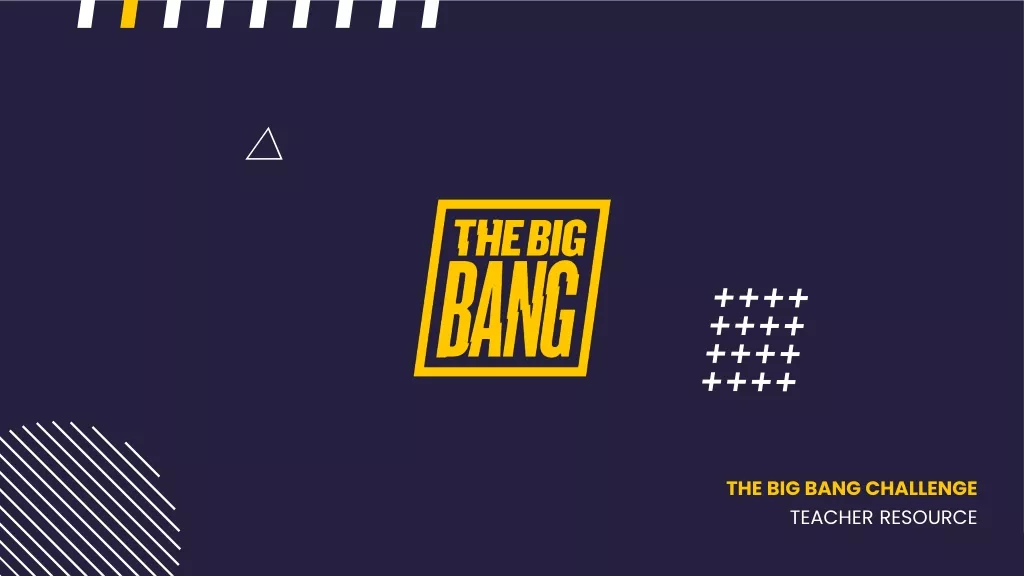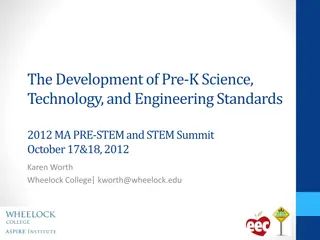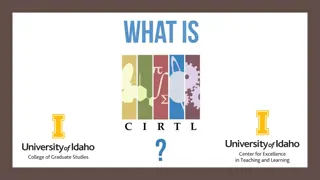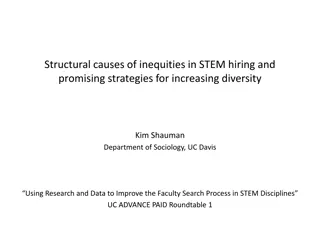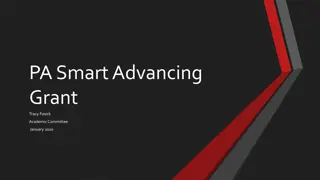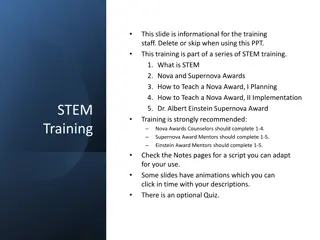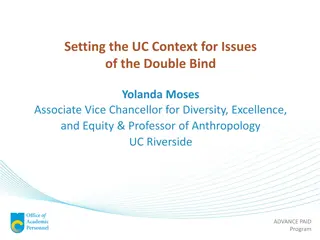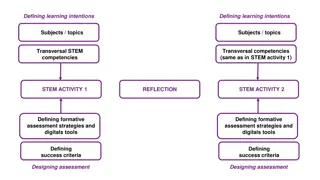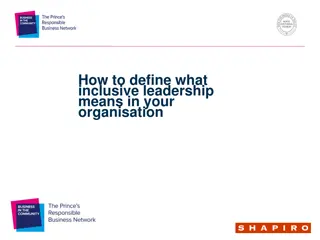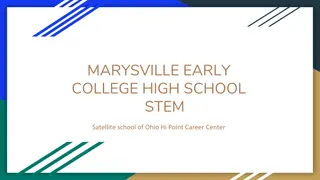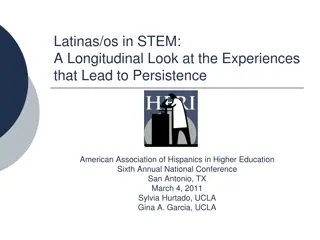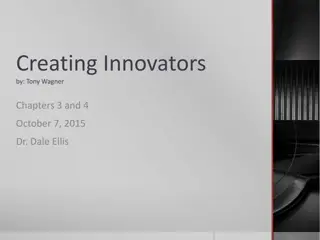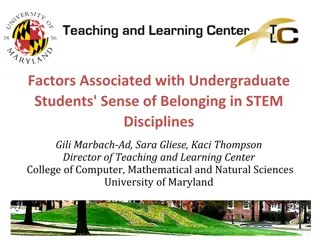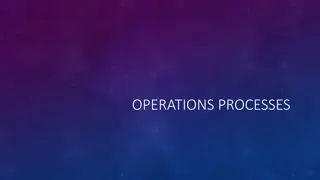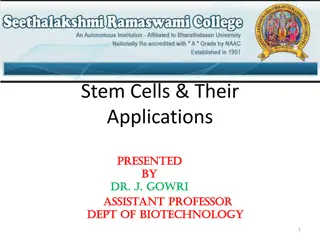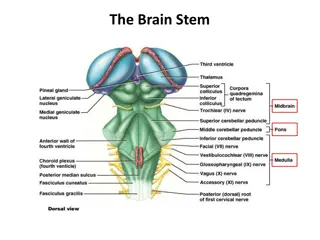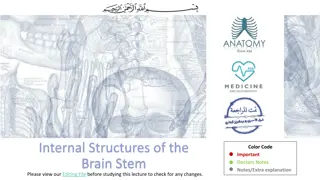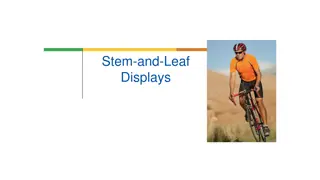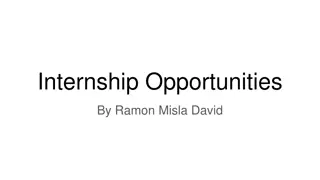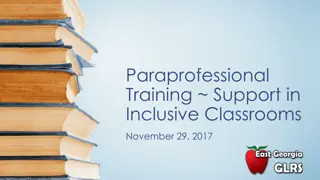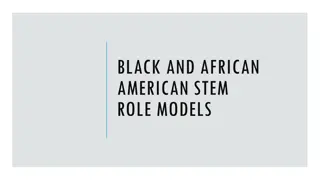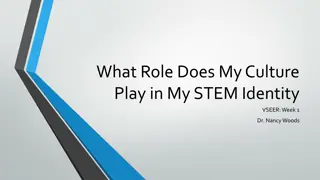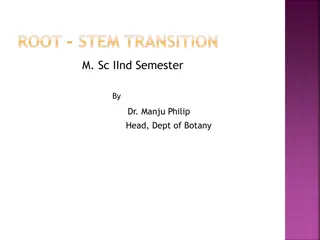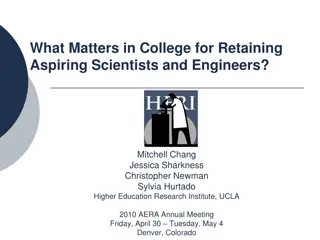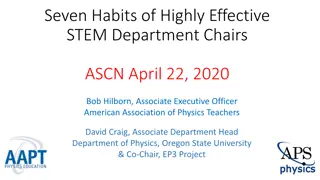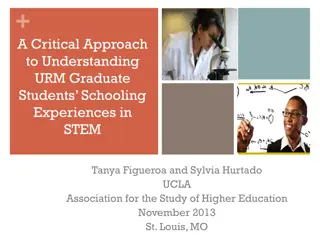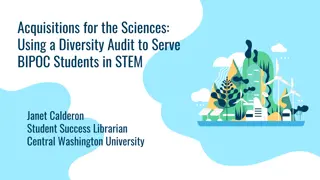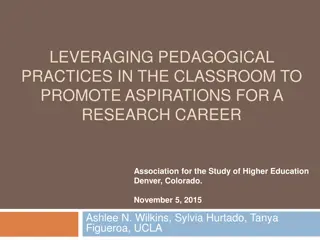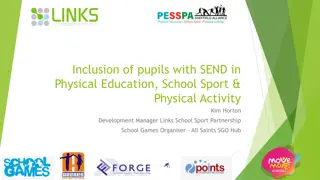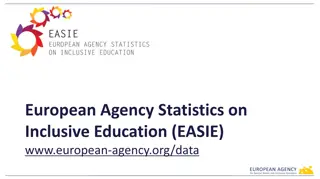Transforming Your School into an Inclusive STEM Learning Center
Transforming a school into an inclusive STEM learning center involves creating a conducive environment for all students to excel in STEM disciplines. By implementing project-based learning, focusing on core STEM subjects, and addressing workforce development strategies, schools can empower diverse learners. Questions about workforce development, stereotype threats, and the role of educators in promoting STEM education are explored, urging schools to embrace Career Technology Education pathways and engage teachers in preparing students for STEM careers.
Download Presentation

Please find below an Image/Link to download the presentation.
The content on the website is provided AS IS for your information and personal use only. It may not be sold, licensed, or shared on other websites without obtaining consent from the author. Download presentation by click this link. If you encounter any issues during the download, it is possible that the publisher has removed the file from their server.
E N D
Presentation Transcript
How (Why) to Transform Your School into an Inclusive STEM Learning Center Dr. Susan Belgrad Professor of Elementary Education CSUN STEM Innovations Team Leader June. 2014 STEM INNOVATIONS TEAM
CSUN STEM Innovations Team Faculty in the Michael D. Eisner College Education and the College of Engineering and Computer Sciences
How Do Schools become Effective STEM Centers for Learning? 1. Create a climate for all students to achieve a STEM-discipline sense of belonging and a growth mindset 2. Become a part of ASCD s Whole Child Initiative; ASCD 3. Seek school-wide Project-Based Learning strategies (offered through CTL); 4. Implement Common Core State Standards with focus on these essential elements: - Science ( and related learning dispositions) - Digital Literacy - Engineering - Mathematics (deep conceptual learning)
Questions we are pursuing: 1) What is the concept of workforce development strategy? Who needs this? Who is on board to deliver it? Who will fund it? Is it possible for diverse (all) learners to access and maintain achievement of the career paths that require STEM leaning? Is the concept of stereotype threat (ST) real and persistent? For girls and women? For students who are Hispanic or African American? What are the costs of this to U.S. education, workforce, quality of life, economy? How might we mitigate any effects of ST by introducing students and their parents to engineering activities as early as the first grade? (Sense of Belonging) 2) 3) 4)
Questions we are currently pursuing: 4) If it is true that STEM-based knowledge will drive the workforce over the next three decades, why aren t educators being advanced and engaged as major players in solving the problem? Isn t teaching math and science in ways that promote conceptual understanding now more important than ever? 5) Should CSUN as a principal agent in the preparation and continuing professional development of teachers and school administrators be responsible for getting this information into schools and helping them to gear up towards bringing Career Technology Education (CTE) pathways into K-12 schooling?
Questions we are currently pursuing: 6) And should we not also be responsible for bringing awareness of the Cool Careers in Science and Engineering to the attention of educators in the Los Angeles region? To parents? To children? 7) How do we begin to engage our elementary, middle school and high school educators?
Why STEM? Why now? STEMbecame an acronym for the fields of study in the categories of science, technology, engineering, and mathematics. The acronym has been used regarding access to United States work visas for immigrants who are skilled in these fields. It has also become commonplace in education discussions as a reference to the shortage of skilled workers and inadequate education in these areas. The initiative began to address the perceived lack of qualified candidates for high-tech jobs. STEMalsoaddresses concern that the subjects are often taught in isolation, instead of as an integrated curriculum. Maintaining a citizenry that is well versed in the STEM fields is a key portion of the public education agenda of the United States. Wikipedia
What are the California Workforce Needs in STEM? There is a diverse range of industries and STEM occupations: Industries in the Professional, Scientific and Technical Services sector: Accounting and Bookkeeping Services Architectural Services, Management Consulting Services Engineering Services- Computer-Integrated Manufacturing Computer Systems Design, Coding and Related Services Research AND Development in Bio-technology These industries also employ workers in a wide variety of STEM occupations such as operations research, analysts, engineers, biochemists and biophysicists, graphic designers, and computer programmers.
Hot Jobs in STEM Occupation Median Pay, 2011 Growth, 2010-2020 Biomedical Engineers $81,540 62% Medical Scientists $76,700 36% Geographers $72,800 35% Database Administrators $73,490 31% Biochemists and Biophysicists $79,390 31% Software Developers $90,530 30% Network and Computer Systems Administrators $69,160 28% Surveyors $54,880 25% Environmental Engineering Technicians $43,390 24% Architects $72,550 24% Environmental Science and Protection Technicians $41,380 24% Epidemiologists $63,010 24% Survey Researchers $36,050 24% Information Security Analysts, Web Developers, and Computer Network Architects $75,660 22% Computer Systems Analysts $77,740 22% Cartographers and Photogrammetrists $54,510 22% Environmental Engineers $78,740 22% Source: U.S. Bureau of Labor Statistics, Occupational Employment Statistics (OES) Psychologists $68,640 22% Anthropologists and Archeologists $54,230 21% Geoscientists $82,500 21% 9
How do we begin to engage our elementary, middle school and high school educators? Many already have!
How do we fund next generation school innovation?
How do we fund next generation school innovation? dolyouthconnect.jpg
How do we fund next generation school innovation? doingwhatmatters ccollege.jpg Pathways Trust Grants
While CA does not have Computer Technology and Engineering standards, many schools have some level of E in STEM engagement. Here is one example: Sound Familiar?
Bridge1 Monroe HS Builds Bridges with Vintage Equlilaterals Monroe High School Engineering and Design students have joined up with 5th grade students at Vintage Elementary School to build bridges. Each 5th grade class is represented by four students from that class. Working in groups along with their high school mentors, students are building bridges out of popsicle sticks and glue. Their goal is to build the strongest bridge. All bridges must have a 14 inch span. Students meet at lunch time on Wednesdays, Thursdays and Fridays. Wednesday, 12 December 2012 18:29 | Written by Debbie Stone
A Brief STEM Activity Sample COOPERATIVE GROUP ACTIVITY Task: Each Team will be responsible for achieving an engineering design with the blocks provided; discussing the science, technology and math principles that affect decisions making and task completion; and completing the engineering notebook page. Time Limit for Creating the structure: 3 minutes
Scratch Here is another example of STEM preparation local schools are using: http://iridescentlearning.org/programs/ familycs/
Student/Family STEM Engagement iridescent-making-machines-cover-255x300 https://picasaweb.google.com/113239471880384339 965/BestOfIridescent?feat=flashalbum#slideshow/56 76104508449069666
Engineering is Elementary Museum of Science, Boston Engineering is Elementary CSUN will train teachers in this program. http://legacy.mos.org/eie/20_unit.php
PROJECT LEAD THE WAY Gateway To Technology Middle School Program Foundation Units Specialization Units Flight and Space Design and Modeling Science and Technology Automation and Robotics Magic of Electrons Green Architecture Energy and the Environment
PROJECT LEAD THE WAY Pathway to Engineering High School Program Foundation Courses Introduction to Engineering Design Principles Of Engineering Specialization Units Civil Engineering and Architecture Computer Integrated Manufacturing Digital Electronics Specialization Courses Capstone Course Aerospace Engineering Engineering Design and Development Biotechnical Engineering
PROJECT LEAD THE WAY High School Program Biomedical Science Medical Interventions Students investigate various medical interventions that extend and improve quality of life, including gene therapy, pharmacology, surgery, prosthetics, rehabilitation, and supportive care Biomedical Innovation/Capstone Course Students work with a mentor, identify a science research topic, conduct research, write a scientific paper, and defend Foundation Units Principles of the Biomedical Sciences Students study research processes, human medicine and are introduced to bio-informatics Human Body Systems Students study basic human physiology, especially in relationship to human health
CSUN ESTEME SCHOOL NETWORK The Enhancing the E in STEM(ESTEME) Initiative is the focus of a vibrant, ongoing partnership of the College of Engineering and Computer Science and the Michael D. Eisner College of Education. It maintains a strong relationship and shared vision to create a sustained Academic Pipeline of engineering and computer-technology curriculum throughout K-16 schooling for all learners.
CSUN ESTEME SCHOOL NETWORK Several informal science organizations join us in offering activities that will inspire students and parents to pursue their STEM studies in which they become prepared to enter the growing high-technology-high knowledge workforce as scientists, engineers, information technology specialists and leaders. Our important ongoing collaboration with the Robotics Education and Competition Foundation (REC); and new relationship with the National Center for Technological Literacy (NCTL) of the Museum of Science, Boston has been further enhanced with our recent agreement to become a Hub-Site Provider for theEngineering is Elementary school program they have offered since 2004. And CSUN is now strongly engaged with Project Lead the Way as we introduce and deliver the resources of their Computer Science and Engineering, Green Technology and Biomed curricula to the schools we serve in the San Fernando, Simi and Santa Clarita Valleys of Southern California.
CSUN ESTEME SCHOOL NETWORK In addition, Iridescent Learning, Los Angeles, an organization that has been funded by NSF is providing the Project with assistance in delivering DIY workshops and E in STEM family activities.The Columbia Memorial Space Center, an organization dedicated to aerospace science and exploration that has been funded by NASA, together with the Sally Ride Science Community, will assist us to assure increased STEM discipline career awareness and school success for elementary- level underserved students and their families. The funding of this Project will result in a disseminatable workforce development strategy for other University-School/Community- Informal Science Networks.
Did you celebrate PI Day with your students last week? Here is an Activity to take home
Celebrate Math Everyday Math Achievement Matters! University of Chicago Everyday Math --- Minute Math Math Their Way Daily Activities
Contact the Stem Innovations Team: Dr. Susan Belgrad susan.belgrad@csun.edu Steve Holle, Center for Teaching and Learning holle@csun.edu
